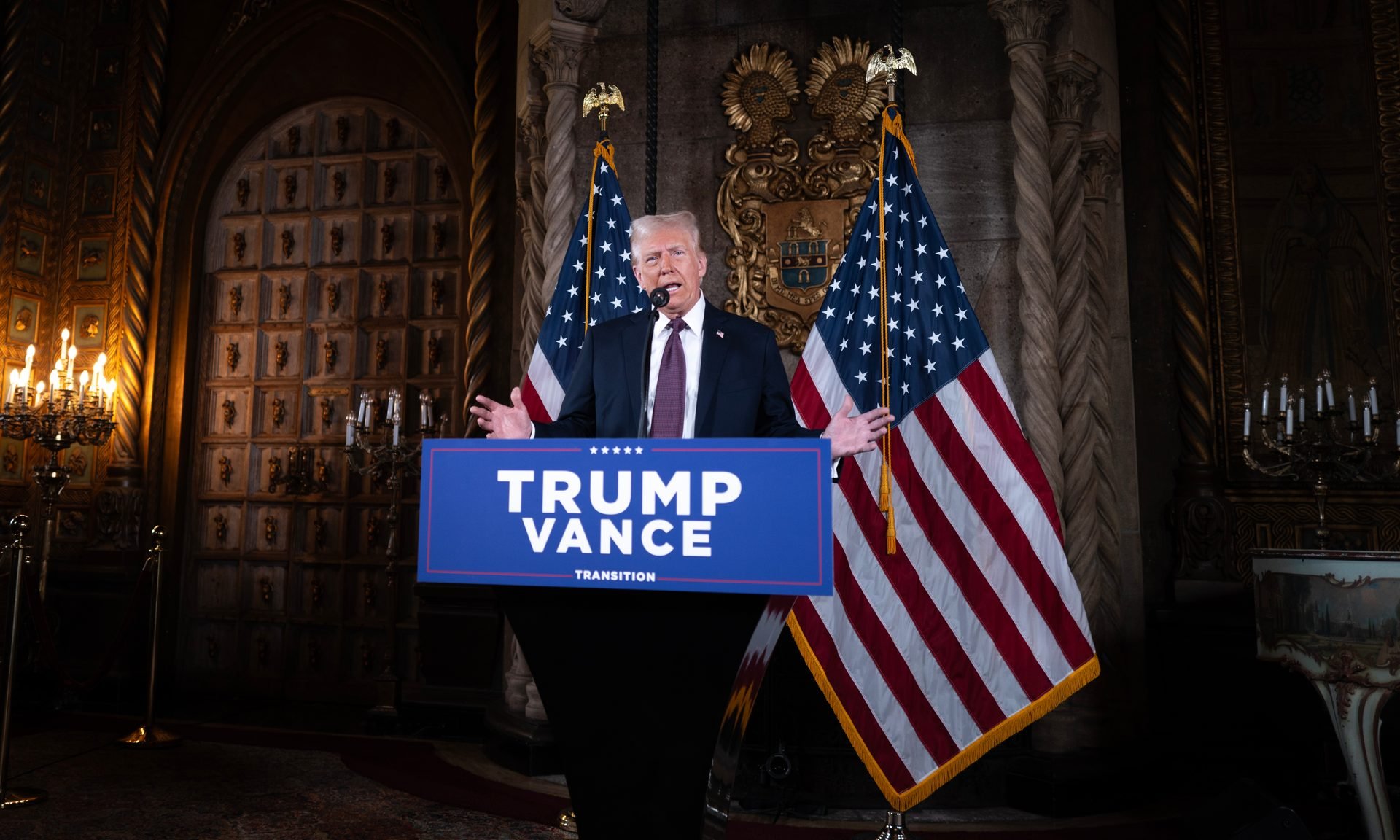How Is Trump Handling the Economy?
Trump is taking major steps to reshape the economy. Voter approval rates are well below 50%.

Many, or all, of the products featured on this page are from our advertising partners who compensate us when you take certain actions on our website or click to take an action on their website. However, this does not influence our evaluations. Our opinions are our own. Here is a list of our partners and here's how we make money.
Updated Dec. 23.
View of Trump’s economic performance has tanked
Approaching the close of President Donald Trump’s first year of his second term in office, Americans are increasingly dour about his economic performance. Here are the findings from some of the most recent polls:<br>
- The Economist/YouGov: 38% of Americans approve of Trump’s handling of jobs and the economy (Dec. 20-22).
- American Research Group: 33% of Americans approve of Trump’s handling of the economy (Dec. 17-20).
- Reuters/Ipsos: 33% of Americans approve of Trump’s handling of the economy (Dec. 12-15).
- Fox News: 39% of voters approve of Trump’s handling of the economy. (Dec. 12-15).
- Quinnipiac Poll: 40% of registered voters approve of Trump’s handling of the economy (Dec.11-15).
- NPR/PBS/Marist: 36% of Americans approve of Trump’s handling of the economy (Dec. 8-11). Americans’ biggest economic concern is overwhelmingly prices (45%).
- Marist: 36% of Americans approve of how Trump is handling the economy (Dec. 8-11).
Trump promises $2K tariff rebate checks as early as mid-2026
On Nov. 17, Trump promised the government would make good on his proposal to send $2,000 tariff rebate checks to non-high-income Americans as early as mid-2026.
Trump floated the idea on Nov. 9 in a Truth Social post in which the president wrote, “People that are against Tariffs are FOOLS!” In his post, Trump also promised to use tariff revenue to start paying down the national debt.
The idea is similar to stimulus checks, first sent out by Trump in 2020 during the brief pandemic recession in his first term and again in 2021 by former President Joe Biden. But in those cases, the funding came from tax payments, not tariff revenue. It would require an act of Congress to issue dividends, Treasury Secretary Scott Bessent said recently.
The Committee for a Responsible Federal Budget (CRFB) says the $2,000 per person “dividend” would cost $600 billion. So far, tariffs have raised $100 billion and, if they stay the course, are on track to raise $300 billion per year.
What’s unclear is if Trump’s proposal would be a one-shot deal or if checks would be distributed annually. Dividends could be paid every other year beginning at the end of next year, according to the CRFB. Delivering $2,000 per-person checks to all low- and middle-income Americans would deplete all tariff revenue every two years. Or if the checks are delivered annually, then they cost twice as much as tariffs bring in.
The CRFB also says the president’s claim about tariff revenue being used to pay off national debt is false. “Under no circumstances is the government doing enough to pay down debt, despite the claims to the contrary,” the CRFB said in an emailed statement.
The question of checks or debt payoff may be moot if the Supreme Court rules against the Trump Administration in a pair of cases challenging the legal basis for the tariffs. The justices could strike down Trump’s reciprocal tariffs and require the U.S. to return funds to companies who have had to pay tariffs. If the justices side with lower courts’ rulings, the CRFB says it would take seven years for the first dividends to be paid.
The Fed makes its third cut of 2025
The Federal Reserve cut rates for the third time in 2025 at its December meeting. The rate was cut by 25 basis points and now sits at 3.50%-3.75%.
Rate decisions impact how much it costs to borrow, as well as savings rates. Low rates benefit borrowers, while high rates increase the yield for savers. The Fed’s decision was made on the heels of a data blackout due to the ongoing government shutdown.
What's happening with Trump's tariffs?
Since February, Trump has announced sweeping tariffs affecting virtually all U.S. trade partners. Here’s your cheat sheet
Since President Donald Trump’s inauguration on Jan. 20, he has wasted no time putting his stamp on the economy. His economic agenda has unfolded via a barrage of executive orders that included mass layoffs of federal workers, department closures, sweeping tariff declarations, as well as sudden reversals of those declarations.
Trump’s rapid-fire actions have roiled financial markets and rattled consumer confidence. What remains uncertain is if the turbulence caused by his economic policies will spark a recession, as some economists have predicted.
Trump's recent actions
Trump fires IRS Head
On Aug. 8, Trump fired Billy Long, the head of the Internal Revenue Service (IRS), after the former GOP congressman served just two months in the role.
Treasury Secretary Scott Bessent was appointed acting head of the IRS.
Long’s ousting follows months of unrest in the agency, including a mass exodus of workers. Six people have led the IRS this year, including Gary Shapley, who served only two days in the position. It’s unclear who will take on the job next.
Long was a controversial pick, having been involved with a firm that distributed a fraudulent tax credit program. As a congressman, he also supported a proposal to abolish the IRS.
However, Long isn’t out of the picture entirely. Shortly after the announcement of his departure, Long said in a statement that he was excited to begin a new ambassadorship in Iceland.
Trump drops labor statistics chief over weak jobs report
On Aug. 1, President Donald Trump fired Erika McEntarfer, the Biden-appointed head of the Bureau of Labor Statistics, after accusing her of manipulating data to damage his administration. Trump provided no supporting evidence for his claim.
McEntarfer’s dismissal followed a worse-than-expected jobs report for July that included significant downward revisions to the number of jobs added in May and June — down by 258,000. The White House claimed the BLS numbers were “unreliable” due to large revisions.
Criticism was swift as economists, media, lawmakers and critics slammed the move and questioned whether economic data produced by the U.S. government would be credible moving forward.
On Aug. 3, Former Treasury Secretary Larry Summers said on ABC News’ “This Week” that an official manipulating jobs report data was “preposterous” adding, “These numbers are put together by teams of literally hundreds of people following detailed procedures that are in manuals. There’s no conceivable way that the head of the BLS could have manipulated this number.” He added that the numbers in the jobs report are in line with those of private sector data sources, adding that the firing “is the stuff of democracies giving way to authoritarianism.”
Also on Aug. 3, on CNN’s “State of the Union,” William Beach, the former BLS Commissioner during Trump’s first term, explained why the president’s claim that McEntarfer couldn’t have manipulated data. “There’s no way for that to happen,” he said. “The commissioner doesn’t do anything to collect the numbers. The commissioner doesn’t see the numbers until Wednesday before they’re published. By the time the commissioner sees the numbers, they’re all prepared, they’re locked into the computer system. The only thing the commissioner does on Wednesday is to kind of do the edits on the text so there’s no hands-on at all for the commissioner.”
On Aug. 4, Trump doubled down on his claim, posting on Truth Social, “Last weeks Job’s Report was RIGGED” and said he would pick “an exceptional replacement.”
Trump's 'one big, beautiful bill' is approved
On July 3, Congress passed President Donald Trump’s requested “one big, beautiful bill.” It adds $3.3 trillion to the national debt over the next decade, largely due to roughly $4.5 trillion in tax cuts. To offset costs, the budget bill makes deep cuts to social programs like Medicaid and food assistance.
Find out more details on what’s in the bill and how it could impact your household’s finances.
Trump doubles tariffs on steel, aluminum to 50%
On May 30, Trump announced that he would double the tariff on imported steel and aluminum to 50%. Trump set the initial 25% levy in March.
The president made the initial announcement at a US Steel plant in Pennsylvania, telling workers there that the move is intended to “further secure the steel industry in the United States.” In a later social media post, he said the new rate would go into effect on June 4.
The United States imports more steel than any other nation — 26.2 million metric tons in 2024, from 79 different countries and territories.
Trump’s tariffs on steel and aluminum are not subject to a federal trade court ruling that blocked most of his recent tariffs. That ruling was quickly put on temporary hold by an appeals court.
Federal appeals court temporarily reinstates Trump’s tariffs
On May 29, a federal appeals court approved a request by the Trump administration to pause a court ruling that would block most of Trump’s tariffs. The appeals court ruling reinstates Trump’s tariffs, at least temporarily.
On May 28, a federal trade court said that Trump does not have the legal authority to implement most of his tariffs including his sweeping “Liberation Day” tariffs, as well as broad tariffs on Mexico and Canada. Most tariffs on China would also be illegal, under the ruling.
The ruling would not apply to Trump’s 25% steel, aluminium, auto or auto parts tariffs.
Trump asks pharmaceutical companies to lower drug prices
On May 12, President Donald Trump issued an executive order promising to lower drug prices, but he offered no details on how it would work or how effective it might be.
Trump said he would order drug companies to reduce prices for all pharmaceuticals to “most-favored nation” levels — the lowest amount a pharmaceutical company charges any other wealthy, developed country. He also said his administration would “end global freeloading” and would take aggressive actions against drug manufacturers that don’t comply. He gave drug makers 30 days to negotiate lower prices.
Trump was unclear about how much he expects drug prices to fall. While signing the executive order, he said prices could be cut somewhere between 59% and 90%. He added, “We’re getting them down 60%, 70%, 80%, 90%. But actually more than that if you think about it in a way, mathematically.”
20k workers cut from Health and Human Services
On March 27, the Trump administration announced that 10,000 workers in the Health and Human Services Department (HHS) would be laid off. Another 10,000 employees have opted for buyouts and early retirements, which brings the total job cuts to 20,000 — about one-quarter of the department’s 82,000 person workforce.
The plan, under the leadership of Health Secretary Robert F. Kennedy Jr., is to restructure the department by consolidating 28 divisions into 15, including the creation of a new division called the Administration for a Healthy America (AHA).
“I want to promise you now, we’re going to do more with less,” Kennedy said in a video posted on YouTube. He added, “The entire federal workforce is downsizing now, so this will be a painful period for HHS.”
The Health and Human Services Department is responsible for protecting public health and administering more than 100 programs. That includes programs that service children, families, seniors, people with disabilities and underserved communities. HHS is also charged with managing Medicaid and Medicare; administering drug and food safety; leading efforts in disease prevention and other medical research; responding to public health emergencies; and providing mental health and substance abuse support programs.
Trump orders Education Department to close
On March 20, Trump issued an executive order to shutter the Department of Education (ED). The order shifts many responsibilities of the department onto states and other federal agencies.
Trump has long vowed to get rid of the ED but cannot fully do so without an act of Congress.
Certain functions of the ED are guaranteed under the law including, as the release mentions, formula funding; federal student loans and Pell grants; funding for special needs students; as well as competitive grantmaking. The order says all statutory functions will continue to be carried out by the federal government.
On March 28, Trump said from the Oval Office that the ED’s $1.6 trillion student loan portfolio would be transferred to the Small Business Administration. He added that oversight of special education services and nutrition programs would be transferred to the Health and Human Services Department.
Secretary of Education Linda McMahon said in a press release, “We’re going to follow the law and eliminate the bureaucracy responsibly by working through Congress to ensure a lawful and orderly transition.”
McMahon also said, “Teachers will be unshackled from burdensome regulations and paperwork, empowering them to get back to teaching basic subjects. Taxpayers will no longer be burdened with tens of billions of dollars of waste on progressive social experiments and obsolete programs. K-12 and college students will be relieved of the drudgery caused by administrative burdens—and positioned to achieve success in a future career they love.”
It’s unclear how the ED will continue to deliver its remaining services with a diminished staff. On March 11, the ED announced it would be reducing its workforce by 50% as of March 21. The ED began the year with 4,133 workers. Since Trump entered office, a total of 1,950 have left from a combination of Tuesday’s firings (1,315); probationary worker layoffs in February (63); and staff who left voluntarily with severance (572). The workers laid off this week will continue to receive pay and benefits until June 9, as well as severance pay.
Trump won’t rule out recession
President Donald Trump stoked recession fears following a Fox News interview that aired on Sunday when he didn’t deny the possibility of a recession. He told Fox News, “I hate to predict things like that. There is a period of transition, because what we’re doing is very big. We’re bringing wealth back to America. That’s a big thing. And there are always periods of, it takes a little time. It takes a little time, but I think it should be great for us.”
Trump’s presidency has been marked by volatility in the markets, largely due to his will-he-won’t-he tariff policies. The S&P 500 reached all-time highs following Trump’s re-entry to the White House but has since dropped; the index is now down 2.6% since Inauguration Day.
Trump pauses tariffs on some Mexican and Canadian goods
On March 6, Trump paused tariffs on all Mexican and Canadian imports under the 2020 free trade deal, known as the United States-Mexico-Canada Agreement. The pause will be in effect until April 2.
Trump's 25% tariffs on goods not included in the trade deal remain in effect. On Tuesday, an additional 10% tariff was also levied on Chinese goods, bringing the total added tariff to 20%.
Keep up-to-date with the latest tariff news here.
Trump wants to change how economic growth is measured
The Trump administration is eyeing a change in how gross domestic product (GDP) is measured in the wake of federal spending cuts.
On Sunday, Commerce Secretary Howard Lutnik told Fox News that the Trump administration may split government spending from GDP. He said, “You know that governments historically have messed with GDP. They count government spending as part of GDP. So I’m going to separate those two and make it transparent.”
Similar remarks were made by Elon Musk, billionaire and leader of the so-called Department of Government Efficiency (DOGE) on Feb. 28. DOGE has recently taken action to lower government spending, which includes firing thousands of federal employees, freezing federal funding and eliminating government contracts.
It’s unclear why the administration has put the target on GDP data transparency since the Bureau of Economic Analysis (BEA) already breaks down government spending at the federal, state and local levels for each quarter. Those results are published by the BEA on a quarterly basis.
Economic data has shown some disappointing figures that include stubborn inflation levels; fewer hires; and lower consumer spending. Consumer confidence in the economy is down, as well. The latter is largely due to Trump’s recent tariff announcements, according to the Conference Board’s recent survey results.
GDP could be the next concern: On March 3, a forecasting tool published by the Atlanta Federal Reserve showed that GDP could contract by a rate of -2.8% in the first quarter of 2025. If GDP does indeed decline, it would be the first time since the first and second quarters of 2022.
Federal Judge says Trump disobeyed order to pause federal spending freeze
On Feb. 10, a federal judge ruled that Trump’s team has continued freezing federal spending and grants. On Jan. 27, the Office of Management and Budget ordered a temporary pause on all federal funding, with some exceptions. Rhode Island District Court Judge John J. McConnell said that Trump’s team has not complied with a court-ordered pause to the spending freeze.
In his decision, McConnell said that the broad, sweeping funding freeze is “likely unconstitutional and has caused and continues to cause irreparable harm to a vast portion of this country.” Federal spending is approved each year by Congress.
The Trump camp told the court that it is “just trying to root out fraud.” The judge ordered Trump to resume the funding of all spending programs that were previously funded and must continue funding other agencies, specifically including the National Institute for Health (NIH). On Sunday, the NIH announced it was capping funding for indirect funding costs at 15%.
It’s unclear if the Trump administration will comply with the judge’s order. Later in the day, the administration filed an appeal.
Trump announces new steel and aluminum tariffs
On Feb. 11, President Trump announced 25% tariffs on all steel and aluminum imports. The tariffs go into effect on March 12.
The top importers of steel to the U.S. include Canada, Mexico, Brazil, South Korea, Japan, Germany, China, Taiwan, Vietnam and Algeria, according to the International Trade Administration. Trump said that no trade partners would be exempt from the tariffs.
During Trump’s first presidency, he imposed a 25% tariff on aluminum and a 10% tariff on steel from Canada, Mexico and the European Union. The tariffs continued under Biden. An analysis of those previous tariffs by the Tax Foundation found foreign exporters largely passed the cost of the tariffs to U.S. companies. The industries that were most impacted by the aluminum and steel tariffs included transportation, construction and packaging industries, according to the analysis.
Trump lays out tax priorities
On Feb. 6, during a closed-door meeting with GOP House leaders, Trump reportedly laid out his tax priorities, which include:
- Extending the expiring 2017 Tax Cuts and Jobs Act.
- Expanding the State and Local Tax (SALT) deduction.
- Enacting tax breaks for products that are made in America.
- Enacting his “no tax on tips” plan.
- Cutting taxes on overtime pay.
- Cutting taxes on Social Security benefits.
- Nixing tax breaks for owners of sports teams.
- Eliminating the carried interest tax deduction
The Committee for a Responsible Federal Budget (CRFB), analyzed Trump’s tax priorities and estimates it would be costly, resulting in a revenue reduction by anywhere from $5 trillion to $11.2 trillion over 10 years; and a 1.3% to 3% reduction in Gross Domestic Product (GDP). The CRFB projected that the tax priorities as proposed would boost debt to anywhere from 132% to 149% of GDP over 10 years, from an estimated 100% at the beginning of 2026, unless the costs of the priorities are otherwise offset.
The tax priority with the greatest economic impact would be extending his 2017 Tax Cuts and Jobs Act, which the CRFP estimates could cost anywhere from $3.9 to $4.8 trillion over a 10-year period.
Federal judge blocks Trump’s federal spending pause
Confusion over the details of a federal funding interruption continued throughout the week with seemingly no clear answer as to whether or not the pause was still in place.
But on Jan. 31, a federal judge in Rhode Island granted a temporary restraining order that blocks the pause. U.S. District Judge Jack McConnell approved the request after hearing arguments in a lawsuit filed by 22 Democratic-led states and the District of Columbia. In the decision, the judge wrote that the White House’s actions likely “violate the Constitution and statutes of the United States.” The restraining order is set to last until the court rules on the state’s motion for a preliminary injunction.
It all started with a memo issued on Jan. 27 by the Office of Management and Budget (OMB), which called for the pause of all federal spending, grants and other financial assistance programs. The OMB said the programs would be reviewed to ensure they align with President Trump’s various executive orders.
Assistance programs and activities that the memo named during the review included, “financial assistance for foreign aid, nongovernmental organizations, DEI, woke gender ideology, and the green new deal.”
But there was little clarity on which specific programs the memo was referring to. Various reports speculated that the pause would have included Medicaid; transportation funding; small business loans; disaster relief aid; FHA mortgage insurance; as well as other funding for state, local and tribal governments. Assistance programs for individuals — Medicare, Social Security, food assistance through the SNAP program and student loans — were expected to continue without interruption.
Late on Jan. 28, after a day of uncertainty and conflicting reports on the scope of Trump's order, a federal judge in Washington D.C. granted a "brief administrative stay" to block the spending freeze pending further examination by the courts. Judge Loren AliKhan's order expired on Feb. 3, at 5 p.m. EST.
The following afternoon, the White House issued a memo rescinding the OMB order, but a later post on X from the White House Press Secretary Karoline Leavitt claimed a funding freeze was still in place. Leavitt said the purpose of the memo was “To end any confusion created by the court's injunction.”
Intention aside, Leavitt’s comments launched even more chatter about the reality of the pause.
However, Sen Chris Murphy (D-CT) confirmed on X that the funding shutdown was still in place.
Sen. Tim Kaine (D-VA) said in a video he posted on X “This thing ain’t over, we’re going to have to keep battling.”
The initial memo set a Feb. 10 deadline for agencies to submit detailed information on programs, projects or activities included in the pause. There may also be possible exceptions on a case-by-case basis, the memo notes.
The pause faces further potential legal wrinkles. The Spending Clause in the U.S. The Constitution gives Congress the power to fund all kinds of programs. Each year, Congress approves funding for grants, loans and financial assistance programs — that makes those programs legal obligations.
The Impoundment Control Act of 1974 requires the executive branch to spend funds that Congress approves of. In January 2020, the U.S. The Government Accountability Office said the OMB’s withholding of obligation funds for the Department of Defense for assistance to Ukraine violated the ICA. In the memo, the GAO wrote, “Faithful execution of the law does not permit the President to substitute his own policy priorities for those that Congress has enacted into law.”
Trump floats tariffs on steel, semiconductors and pharmaceuticals
On Jan. 27, Trump said he plans to enact tariffs on steel, aluminum, copper, pharmaceuticals, computer chips and semiconductors, in the hopes of bringing manufacturing back to the U.S.
Trump said tariffs on computer chips and semiconductors from Taiwan could be anywhere from 25% to 50% or even up to 100%. Tariffs on chips and semiconductors could lead to higher prices for computer products including smartphones.
In response, the Taiwanese government said the current business model with the U.S. is a win-win, while the Taiwan economy ministry called the two nations’ semiconductor businesses “highly complementary to each other.”
The Taiwan Semiconductor Manufacturing Co. (TSMC) — the largest producer of semiconductors in the world — is investing $65 billion in Arizona for new chip manufacturing plants, as part of the Biden administrations’ CHIPS and Science Act. The Act also gave funding to U.S. companies for the creation and expansion of chip manufacturing plants.
Trump’s campaign promises
Here are some of the major proposals Trump made during the 2024 election, along with the opinions of economists and other experts on how those promises could play out.
NerdWallet's campaign deep dives
What a Trump win means for your personal finances and the economy President Donald Trump will need to get to work on some of the economic promises he’s made during the election. Multiple analyses of Trump's economic plans project that his presidency is likely to reignite inflation.
What Trump’s win means for small business Here are some of the proposals that may have the biggest impacts on small-business owners across the U.S. including tariffs, tax cuts and more.
What Would Kamala Harris’ Opportunity Economy Look Like? Find out where Vice President Kamala Harris stands on economic issues like battling inflation, medical debt, jobs, health care, housing, child care, small businesses and more.
How Harris and Trump Want to Battle Inflation and Lower Prices Both presidential candidates are promising to give people what they want: to pay less money for most everything. But whether Trump or Harris are capable of lowering prices is debatable.
What Trump and Harris Have in Store for Your Taxes The campaign proposals that most directly impact your finances are tax cuts and credits, and the candidates’ positions couldn’t be more different.
Trump and Harris embrace no-tax-on-tips, experts say it’s bad policy The presidential candidates promise to exempt workers from paying taxes on their tips. But the problem with no-tax-on-tips proposals, experts say, is that they don’t address the fundamental needs of tipped workers.
How Trump and Harris Aim to Address Your Health Care When it comes to health care, the candidates have been light on the details. Harris has focused on things like lowering prescription drug prices; expanding Medicare care coverage; and restoring federal abortion rights. Trump says he supports IVF coverage, but wants to leave abortion to the states. He also said that he has only a “concept” of a plan to replace the Affordable Care Act.
Labor expert: Trump’s Immigration Plan Would ‘Wreak Havoc’ on Workforce, Economy If Trump were to be elected and able to enact his plans to remove millions of people, it could have disastrous effects on the economy. One labor expert explains why.
Harris v. Trump on Student Loans: Where the Candidates Stand As president, Harris would likely champion student loan relief and free community college. Trump would likely restrict or dismantle loan forgiveness and promote access to non-traditional degrees.
Smart Money’s 2024 presidential election series
Hosts Sean Pyles and Anna Helhoski discuss the grand economic promises made by presidential candidates and the intricate realities of presidential influence on the economy to help you understand the real effects on your daily finances.
(Photo by Scott Olson/Getty Images News via Getty Images)
Article sources
NerdWallet writers are subject matter authorities who use primary,
trustworthy sources to inform their work, including peer-reviewed
studies, government websites, academic research and interviews with
industry experts. All content is fact-checked for accuracy, timeliness
and relevance. You can learn more about NerdWallet's high
standards for journalism by reading our
editorial guidelines.
Related articles







